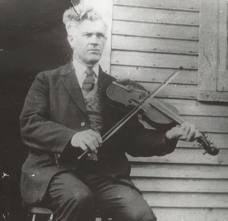Annotation:Reel de la tuque bleue: Difference between revisions
No edit summary |
No edit summary |
||
| (7 intermediate revisions by the same user not shown) | |||
| Line 1: | Line 1: | ||
---------- | |||
{{TuneAnnotation | |||
|f_tune_annotation_title= https://tunearch.org/wiki/Annotation:Reel_de_la_tuque_bleue > | |||
|f_annotation='''REEL DE (LA) TUQUE BLEUE.''' AKA and see "[[Blue Cap Reel]]," "[[Blue Garters (The)]]," "[[Quadrille des bûcherons: 6ème figure]]," "[[Snowshoer (The)]]," "[[Snowshoer's Reel (1)]]," “[[Tuque Bleue]].” French-Canadian, Reel. G Major (Miller & Perron, Page): F Major (Cranford/Holland). Standard tuning (fiddle). AABB (Carlin): AA'BB' (Begin, Cuillerier). "Reel de la tuque bleue" is from the repertoire of Québec fiddler Joseph Allard (1873-1947), who recorded it in Nov. 1929 for Victor records (accompanied by piano and a jew’s harp). The reel is a variant of Francis O'Neill's "[[Blue Garters (The)]]," obtained from the repertoire of Chicago fiddler John McFadden, originally from County Mayo. According to Anne Lederman (entry on “Fiddling”, '''Encylcopedia of Music in Canada''', 1992), Montreal fiddler Joseph Allard’s (1865-1947) version of this tune, recorded in 1930, became popular in English-speaking Canada as “[[Snowshoe Reel]]/[[Snowshoer's Reel (1)]].” However, Allard's version is predated by Montreal fiddler J.O. LaMadeleine who had recorded a slightly 'crooked' (irregular meter) version in 1928 under the title "[[Quadrille des bûcherons: 6ème figure]]." “Down East” Canadian radio and TV fiddler Don Messer’s version of the tune was called “The Snow Shoers.” | |||
---- | |||
---- | |||
'''REEL DE (LA) TUQUE BLEUE.''' AKA and see "[[Blue Cap Reel]]," "[[Quadrille des bûcherons: 6ème figure]]," "[[ | |||
<br> | <br> | ||
<br> | <br> | ||
The name Les tuques bleues refers to a key item in the uniform of the old Montreal Snow Shoe Club (MSSC), which was led by powerful anglophones such as Lord Stanley, known today mainly for a silver cup he donated for a hockey game. The reel has long been a popular staple for American contra dancing. | |||
<br> | <br> | ||
<br> | <br> | ||
Quebec fiddler Pascal Gemme remarks in his blog entry on the tune, the reel "is the only tune in 'F' that's left in the general repertoire of [Québécois] square tunes." See also note for “[[annotation:Tuque Bleue|Tuque Bleue]].” [[File:allard.jpg|400px|thumb|right|Joseph Allard]] | |||
|f_source_for_notated_version=fiddler Dawson Girdwood (Perth, Ottawa Valley, Ontario) [Bégin]. | |||
|f_printed_sources= Bégin ('''Fiddle Music in the Ottawa Valley: Dawson Girdwood'''), 1985; No. 6, p. 20. Carlin ('''Master Collection'''), 1984; No. 70, p. 49. Cranford ('''Jerry Holland: The Second Collection'''), 2000; No. 178, p. 67 (appears as “La Touque Bleu”). Cuillerier ('''Joseph Allard'''), 1992; p. 16. Jean Duval ('''La Musique de Jospeh Allard 1973-1947'''), 2018; No. 41, p. 21. Miller & Perron ('''New England Fiddlers Repertoire'''), 1983; No. 159. Page ('''Ralph Page Book of Contras'''), 1969; p. 3. Songer ('''Portland Collection, vol. 2'''), 2005; p. 210. | |||
Alan Snyder’s Cape Breton Fiddle Recordings Index [http://www.cbfiddle.com/rx/tune/t3067.html]<br> | |f_recorded_sources=Philo 2022, Louis Beaudoin - "Beaudoin Family" (1976). Victor 263674-a (78 RPM), Joseph Allard (1930). "Les sessions du Vices & Versa - 15e anniversaire" (2021. Appears as 1st tune of "Le set à Martine"). | ||
|f_see_also_listing=Alan Snyder’s Cape Breton Fiddle Recordings Index [http://www.cbfiddle.com/rx/tune/t3067.html]<br> | |||
Jane Keefer’s Folk Music Index: An Index to Recorded Sources [http://www.ibiblio.org/keefer/t11.htm#Tuqbl]<br> | Jane Keefer’s Folk Music Index: An Index to Recorded Sources [http://www.ibiblio.org/keefer/t11.htm#Tuqbl]<br> | ||
Hear Joseph Allard's 1930 recording at the Virtual Gramophone [http://www.collectionscanada.gc.ca/obj/m2/f7/12779.mp3] and at youtube.com [https://www.youtube.com/watch?v=FOCo7Z-nc8A]<br> | Hear Joseph Allard's 1930 recording at the Virtual Gramophone [http://www.collectionscanada.gc.ca/obj/m2/f7/12779.mp3] and at youtube.com [https://www.youtube.com/watch?v=FOCo7Z-nc8A]<br> | ||
See Pascal Gemme's blog entry and standard notation transcription [http://pascalgemme.com/tradquebec/la-chicanneuse-la-tuque-bleu/]<br> | See Pascal Gemme's blog entry and standard notation transcription [http://pascalgemme.com/tradquebec/la-chicanneuse-la-tuque-bleu/]<br> | ||
}} | |||
------------- | |||
---- | |||
Latest revision as of 17:59, 2 March 2024
X:1 T:Reel de la tuque bleue S:Joseph Allard (1873-1947, Montreal, Que.) M:C| L:1/8 R:Reel D:Victor 263674A (78 RPM), Joseph Allard (1931) F:http://www.collectionscanada.ca/obj/m2/f7/12779.mp3 Z:Transcribed by Andrew Kuntz K:F f2cf a2gf|eceg bg/g/g-e|f2cf fagf|edcB A<F-F2e-| f2 cf fagf|eceg bg/g/g-e|f2cf fagf|ed(c/4d/4c/)B A<F-F2|| c|A<Fc2 A<F GA|B<G d2 BGGB|A<Fc2 A<F GA|B-dcB AFFc| A<Fc2 A<F GA|B<G d2 BGGB|A<Fc2 A<F GA|B-dcB AFFe-||
REEL DE (LA) TUQUE BLEUE. AKA and see "Blue Cap Reel," "Blue Garters (The)," "Quadrille des bûcherons: 6ème figure," "Snowshoer (The)," "Snowshoer's Reel (1)," “Tuque Bleue.” French-Canadian, Reel. G Major (Miller & Perron, Page): F Major (Cranford/Holland). Standard tuning (fiddle). AABB (Carlin): AA'BB' (Begin, Cuillerier). "Reel de la tuque bleue" is from the repertoire of Québec fiddler Joseph Allard (1873-1947), who recorded it in Nov. 1929 for Victor records (accompanied by piano and a jew’s harp). The reel is a variant of Francis O'Neill's "Blue Garters (The)," obtained from the repertoire of Chicago fiddler John McFadden, originally from County Mayo. According to Anne Lederman (entry on “Fiddling”, Encylcopedia of Music in Canada, 1992), Montreal fiddler Joseph Allard’s (1865-1947) version of this tune, recorded in 1930, became popular in English-speaking Canada as “Snowshoe Reel/Snowshoer's Reel (1).” However, Allard's version is predated by Montreal fiddler J.O. LaMadeleine who had recorded a slightly 'crooked' (irregular meter) version in 1928 under the title "Quadrille des bûcherons: 6ème figure." “Down East” Canadian radio and TV fiddler Don Messer’s version of the tune was called “The Snow Shoers.”
The name Les tuques bleues refers to a key item in the uniform of the old Montreal Snow Shoe Club (MSSC), which was led by powerful anglophones such as Lord Stanley, known today mainly for a silver cup he donated for a hockey game. The reel has long been a popular staple for American contra dancing.


